Abstract
Introduction:
Communicating risk to the public continues to be a challenge for public health practitioners working in the area of climate change. We conducted a scoping literature review on the evaluation of risk communication for extreme weather and climate change to inform local public health messaging, consistent with requirements under the Ontario Public Health Standards (OPHS), which were updated in 2018 to include effective communication regarding climate change and extreme weather.
Methods:
Search strategies were developed by library information specialists and used to retrieve peer-reviewed academic and grey literature from bibliographic databases (Medline, Embase, Scopus and CINAHL) and Google country specific searches, respectively. The search strategy was validated through a workshop with experts and community stakeholders, with expertise in environment, health, emergency management and risk communication.
Results:
A total of 43 articles were included. These articles addressed issues such as: climate change (n = 22), flooding (n = 12), hurricane events (n = 5), extreme heat (n = 2), and wild fires (n = 2). Studies were predominantly from the US (n = 14), Europe (n = 6) and Canada (n = 5).
Conclusion:
To meet the OPHS 2018, public health practitioners need to engage in effective risk communication to motivate local actions that mitigate the effects of extreme weather and climate change. Based on the scoping review, risk communication efforts during short-term extreme weather events appear to be more effective than efforts to communicate risk around climate change. This distinction could highlight a unique opportunity for public health to adapt strategies commonly used for extreme weather to climate change.
Keywords: climate change, extreme weather, risk communication
Highlights
We conducted a scoping literature review, validated through a workshop with experts and stakeholders, on risk communication for extreme weather and climate change (EWCC) to inform local public health messaging.
Risk communication efforts during short-term extreme weather events appear to be more effective than efforts to communicate risk around climate change.
This distinction could highlight a unique opportunity for public health to adapt strategies commonly used for extreme weather to climate change.
A conceptual framework is presented to support EWCC risk communication, build adaptive capacity and coordinate recommended actions across short- and long-term timescales.
Introduction
Extreme weather and climate change (EWCC) have well-documented impacts on population health.1 It is possible that a changing climate will not only exacerbate existing health issues but will also create new health burdens for our population.2 These impacts will likely have a greater impact on vulnerable populations, such as those living in rural and remote communities. 3 Local public health practitioners have begun planning for health-related climate impacts through activities such as vulnerability assessments,4 but the complexity of EWCC continues to be a challenge for activities at the local level.5
One aspect of EWCC that presents a consistent challenge for public health practitioners is in communicating risk to the public.6 Risk communication is an evidence-based approach to communicating effectively with the public in times of controversy,7 and effective risk communication is an important first step toward reducing community vulnerability to EWCC.8 Unfortunately, risk communication activities aimed at mitigating the human health impacts of EWCC continue to be challenging, despite their critical importance.9 This was recently described by Pilla et al., in terms of communicating flood risks to the public when households pay more attention to past flood events than to scientific assessments of flood risk.10 During extreme weather, risk communication tends to focus on short-term messaging around the hazards and protective actions that need to be taken by organizations and individuals during these events. In contrast, climate change often requires long-term proactive risk communication strategies that motivate adaptive changes to infrastructure and the built environment to ultimately improve climate resiliency and safeguard the continuity of operations of public health institutions.11
Public Health Ontario supports public health unit staff and other health professionals throughout Ontario in the area of EWCC by providing scientific and technical evidence-based advice. In 2018, the Ontario Public Health Standards (OPHS; http://www.health.gov.on.ca/en/pro /programs/publichealth/oph_standards/), which identify the requirements for public health programs and services to be delivered by Ontario's 35* public health units, were updated to include a requirement to effectively communicate with the public regarding topics such as climate change and extreme weather, based on an assessment of local needs. This recent update underscores the need for public health practitioners to develop and assess risk communication strategies in the area of EWCC. We conducted a review of previous research on the topic of risk communication during EWCC, particularly the evaluation of risk communication strategies, with the ultimate aim of supporting public health practitioners. Given the unique challenges for practitioners and the limited evidence that exists in this area, the review was designed as a scoping review to incorporate a wider range of domains relevant to the topic of risk communication, extreme weather, and climate adaptation. As the scoping review evolved, an expert/stakeholder consultation workshop was held to validate the scoping review and provide additional insights and perspectives on risk communication gaps related to EWCC. This paper describes the results of our scoping review and the expert workshop; with particular focus on the gaps and challenges that were identified and later used to develop a conceptual framework to aid public health professionals working in this area.
Prior to 2018 there were 36 local public health units in Ontario. There was a merger of two health units in 2018, resulting in a total of 35 local public health units across Ontario.
Methods
The scoping review was based on an established methodological framework for scoping reviews.12 Four databases (Medline, Embase, Scopus and CINAHL) were searched for peer-reviewed literature in the English language, published between 1999 and 2013. The search also included grey literature identified from site-specific non-commercial Google searches for Canada, the US, Australia and international organizations. No limitations were placed on the bodies or agencies communicating risk, or the audiences receiving information. There were also no limitations on the type of communication, medium or article. Search strategies (available upon request from the authors) were developed and peer-reviewed by Library Information Specialists. The search strategies were built using keywords and syntax specific to each database to identify literature addressing one or more of the following research questions:
(i) What are the current practices in communicating EWCC risks in the peer-reviewed literature?
(ii) Which of these current practices have been evaluated for effectiveness?
(iii) Which theoretical frameworks from the literature explain current practices? and/or
(iv) What are the research gaps in communicating EWCC risks?
A one-day information-gathering and validation workshop was held in Toronto on February 10, 2014. The workshop: Communicating about A Different Ontario: Risk Communications, Extreme Weather and Climate Change, included thirty individuals representing community stakeholders with expertise in environment, health, emergency management and risk communications from local, municipal (rural and urban), provincial and federal jurisdictions. Participants worked in small focus groups that reflected the diversity of attendees. The thematic content areas identified through the scoping review were presented to participants, who were asked to describe experiences with any of the practices identified through the scoping review. Examples from lived experience were sought to confirm or challenge the findings from published literature. The workshop was used to select the practices identified through the scoping review that municipal, provincial and/or federal public health practitioners and allied stakeholders viewed as effective or promising. The workshop also provided additional insights and perspectives on risk communication gaps related to EWCC. Workshop proceedings and evaluations were summarized to enhance and validate the final search strategy.
Following the workshop, the final search strategies were executed on February 26, 2014†. Articles were screened and assessed by two research coordinators. A flow diagram illustrating the screening process is shown in Figure 1. During the screening process, reviewers relied on consensus decision making to resolve any conflicts. A total of 1880 articles were retrieved from database and Google searches. Articles were excluded if they were duplicates (n = 326) or if they addressed psychological responses and recovery of individuals from extreme weather events (as these articles focused on individuallevel response instead of organizationallevel), or if they reported solely on climate change impacts in the absence of references to extreme weather (n = 1449). The remaining 105 articles were reviewed and those not meeting the screening questions (n = 67) were excluded. Three screening questions were used:
Figure 1. Flow diagram of article selection.
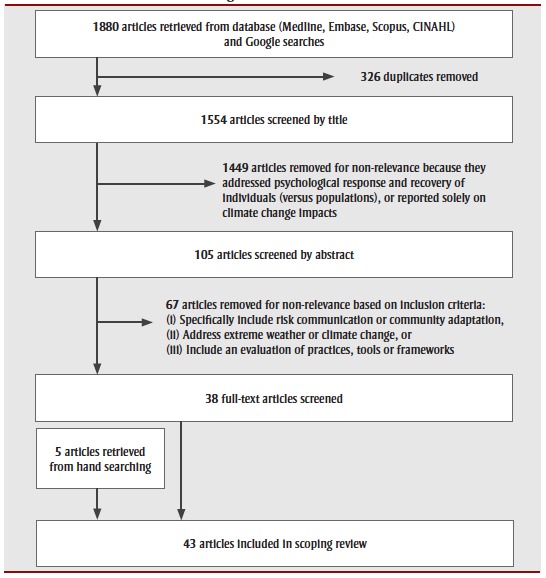
(i) Does the article specifically include risk communication or community adaptation?
(ii) Does the article address some aspect of extreme weather or climate change?
(iii) Does the article include an evaluation of practices, tools, or frameworks using qualitative, quantitative or mixed research methods?
An additional 5 articles were included based on hand searching of key references.
Articles were charted, or mapped, in Excel spreadsheets to enable reporting of results.
These descriptive summaries captured country; main objective and study design; population, type of extreme weather, and key findings (Table 1). Based on an established framework for scoping reviews,12 the narrative findings were presented in two ways: (i) basic numerical analysis of the nature and distribution of the studies; and (ii) thematic grouping of studies by research design and emerging topic. Using this narrative synthesis approach, the following common themes were identified: risk communication, risk perception, engagement of vulnerable populations, community-based strategies, public health, adaptation and resilience. The theme of risk communication was examined in detail by identifying and grouping practices that were used to communicate risk.
Table 1. Articles included in the scoping review.
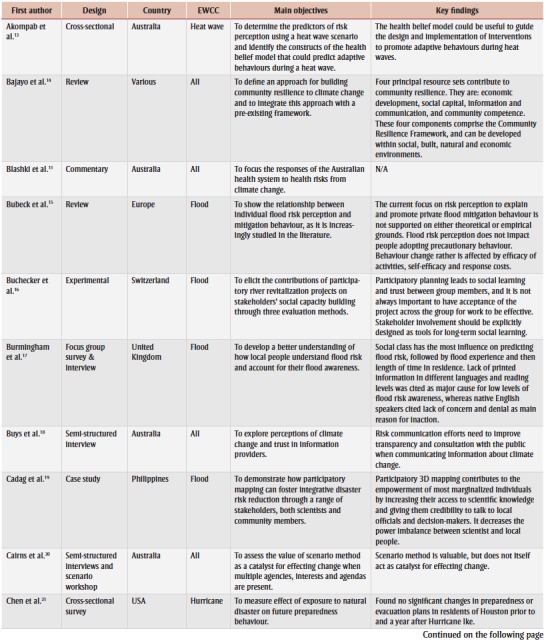 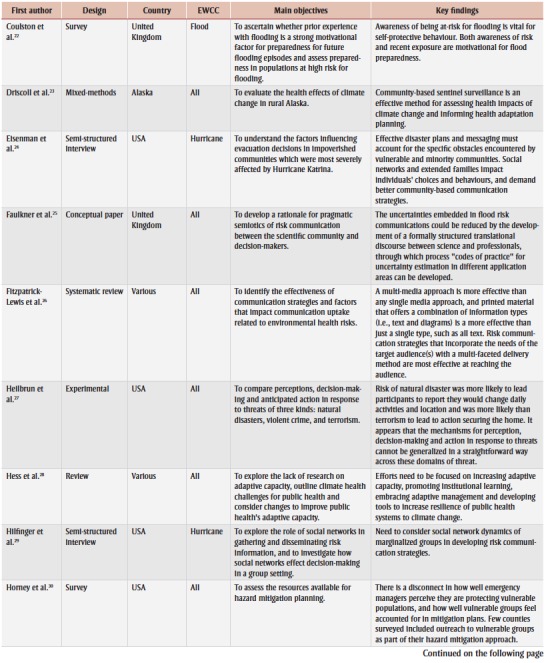 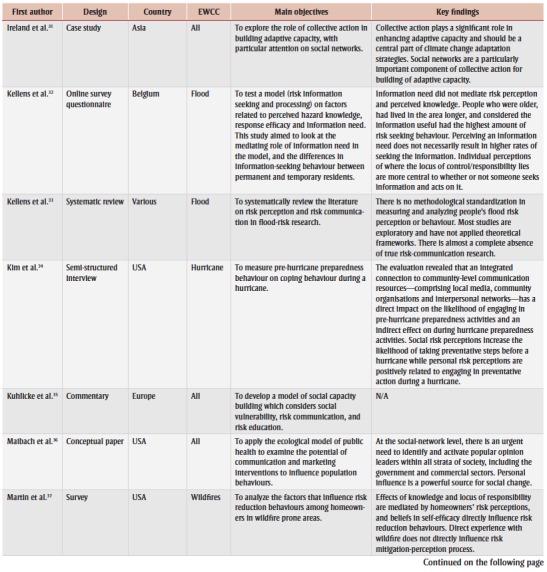 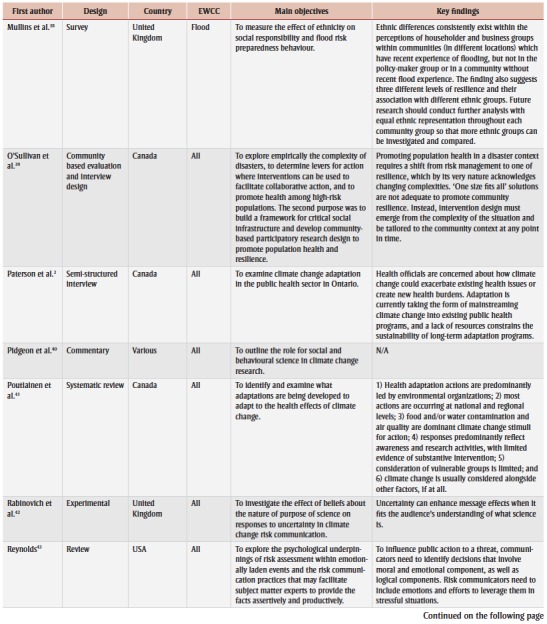 
|
The original search was conducted in February 2014. A second search was conducted in March 2016. The updated literature search did not identify literature that departed from the original search.
Results
The scoping review focused on the communication media and practices used for EWCC risk communication and did not seek to assess quality or weight of evidence. 12 The 43 articles that were included addressed various types of EWCC risk communication: climate change (n = 22), flooding (n = 12), hurricane events (n = 5), extreme heat (n = 2), and wild fires (n = 2)‡. The articles were of disparate and complementary study types: five conceptual models, eight reviews or systematic reviews, five experimental studies, eleven qualitative studies, eight surveys, two case studies, and four commentaries. There were fourteen studies from the United States, six from Europe, and five from Canada. The remaining eighteen studies were from Australia, Asia or international collaborations. Grey literature was used to identify how EWCC messaging was created and delivered rather than for its content. Article summaries are presented in Table 1.
A systematic review of environmental health risk communication suggested risk communications should involve multimodal delivery through many media channels, including radio, television, printed materials, classroom presentations, and Internet-based campaigns.26 In total, the scoping review identified eight unique risk communication practices (Table 2). The two most common practices were public media campaigns, including radio and Internet-based messages, and organization or expert-led presentations or workshops to communities affected by natural hazards. Public media risk communication campaigns typically originated in government and were focused on uniformity and continuity to effect behavioural intention and change.50Within Ontario, communication activities such as promotional messaging, response guidelines, and heat alerts and warning systems were typical risk communication tools used in practice.2
Table 2. Risk communication practices identified.
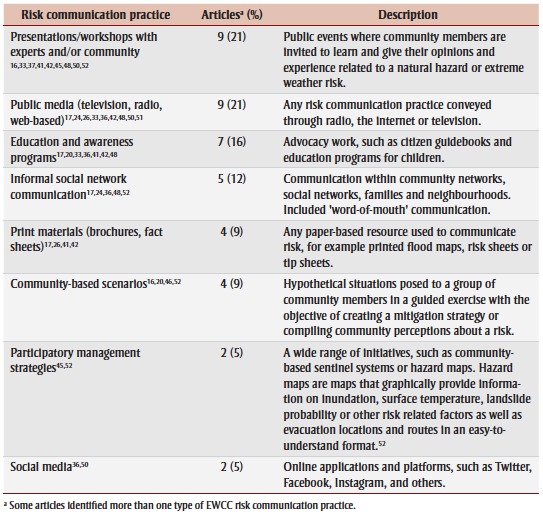 |
The topic of communicating uncertainty around climate change was identified, along with suggestions for improving communication around uncertainty, which included collaboration25 and carefully targeting messages to each unique audience.42 Bridging the expert-public divide to improve risk communication was also highlighted as necessary and could include defining standards and increasing knowledge exchange among different domains of learning and practice.25
Risk communication themes
Key themes around successful risk communications strategies were: risk perception, targeting vulnerable populations, and engaging with communities (Table 3). The first theme, individual risk perception, was influenced by factors such as age, income, education, credibility, and emotion.13,43 For example, self-efficacy and feelings of adequate preparedness were positively correlated with risk reduction behaviours in communities at high risk for wildfires.37
Table 3. Factors that facilitate or impede the success of risk communication strategies.
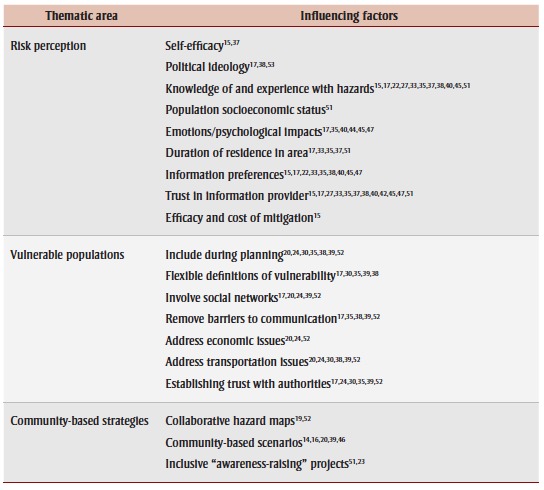 |
A second theme involved engaging vulnerable groups, such as low-income communities, the elderly, racial and ethnic minorities, and people with disabilities. This theme highlighted the challenges vulnerable communities face in seeking and processing risk communication information, including complex language, information overload and contradictory information.45 This was illustrated through interviews with low-income residents fleeing Hurricane Katrina where the low-prevalence of car ownership resulted in heavy reliance on public transportation infrastructure. 24 A disconnect was noted between how well emergency managers perceive they are protecting vulnerable groups, versus how well vulnerable groups feel accounted for in mitigation plans.30
The third and final theme addressed the importance of leveraging social networks and creating strategies housed [or based] in communities. For example, people were more aware of extreme weather risks and more likely to initiate protective activities if they were involved in a participatory exercise.51 Broader involvement of civil society organizations was also highlighted by a review that found that many CSOs, such as the Red Cross and YMCA, play important social roles in health adaptation and community engagement.32 The reviewed studies suggest that public participation measures with diverse community stakeholders are the most effective means to create awareness of potential disasters, encourage individual responsive action, and increase community trust and cooperation in planning and messaging.23
Evaluation of risk communication
Community-based strategies were mostoften evaluated for their effectiveness in EWCC risk communication. For example, the production of community-based flood hazard and evacuation maps was identified as an “effective method of raising public awareness while fostering the active participation of the community”.52 Evaluations also identified increased awareness of self- and mutual aid efforts in community-based flood mitigation. These results support community engagement practices around a specific threat, collaboration among key actors28, and enhancing self-efficacy, as key factors in successful risk communication.
One study described a community-based scenario that involved government, private sector and environmental groups working together to explore the implications of the proposed expansion of a major port facility.20 A workshop presented 4 potential futures, ranging from an ideal “showcase region” to the most negative “development at all costs.” The authors observed that the scenario exercise did not motivate meaningful followup actions. They concluded that the scenario approach is valuable for enabling “democratic dialogue” – and bringing together diverse perspectives – but does not act as an effective “catalyst for bringing about consensus-driven collaborative change in support of policy development and planning.” The authors attributed weak engagement to poor identification of underlying value systems and a failure to create a shared foundational knowledge from which all participants could work.
A second study involved an iterative and participatory process for communitybased sentinel surveillance.23 The process developed community metrics to measure the health impacts of climate change, and the evaluation examined the effectiveness of using community residents as central communication sources. It also considered how the process of collecting data served to increase residents’ awareness of climate change impacts in their community. Community members became more aware and informed of health-related impacts and outcomes and became motivated to contribute to ongoing data collection and to plan for climate adaptation.
Effective risk communication was often defined as a two-way exchange of information between parties (e.g., government, public, community, expert).35 Involving stakeholders in the risk communication planning and discussion stages may increase their commitment and overall satisfaction with mitigation and preparedness projects.16 This highlights the importance of bidirectional communication and stakeholder engagement in EWCC risk communications.
Information-gathering and validation workshop
Comments and evaluations from the oneday information-gathering and validation workshop were used to validate our final search strategy [updated in 2016]. Themes from the scoping review were shown to participants who described experiences with relevant practices from the literature. Two key themes arose during the workshop: challenges related to (i) communicating uncertainty and (ii) communitybased participation.
The stakeholder group identified two EWCC risk communications strategies as priorities: participatory flood/hazard mapping and using case study examples in messaging. Several articles in the scoping review mentioned the power of stories and personal narratives in making EWCC messaging more readily accessible and bidirectional. Unlike official messaging from a government agency, community residents can more easily relate to stories and share their own experiences with other community members.
Key priorities included: engaging community stakeholders in the “broader social fabric” (e.g., Boys and Girls Clubs, community centres) on climate change issues; expanding traditional networks to include inter-institutional expertise among provincial, municipal, and federal actors; and developing differentiated risk-communication strategies for rural and urban areas.
Practitioners agreed that communicating EWCC risks effectively requires individuals and communities to develop self-efficacy and empowerment. This is accomplished by ensuring that community members take an active role in developing preparedness messages for fellow residents. Two participants expressed concern that EWCC risk communications with socioeconomically vulnerable populations must be handled sensitively because such vulnerable audiences do not self-identify as being vulnerable. Participants expressed concern that EWCC risk communication seems to only focus on physical infrastructure and does not address sociodemographic issues. Workshop participants concluded that EWCC risk communicators should use community-based approaches that also connect with and support the specific messaging needs of intergenerational audiences.
Another theme from the workshop was the need to support communities of practice for EWCC risk communication. In part, this workshop guidance reflects the diverse range of audiences and outlets for EWCC messaging and materials. Crosssectoral communities of practice could help to plan and communicate more broadly and support more effective and integrated communications. Workshop participants agreed that media partnerships should be developed to create credible and well-accepted messages that help build social capacity for climate adaptation.
The scoping review and validation workshop both identified factors that may influence risk communication effectiveness— self-efficacy, prior experience with a hazard, trust in the risk communicator, and duration of residence in risk-prone areas—but these may have limited generalizability to EWCC because they have predominantly come from evaluations of risk communications related to flooding. Challenges to EWCC risk communication include bridging shorter-term hazard preparedness with long-term climate adaptation. One model called “Local Climate Change Visioning” outlined linking mitigation and adaptation measures through community scenario planning, a process that includes facilitation.46 This model involved informal communication or storytelling networks for flood and climate change scenario planning in Vancouver, British Columbia. It did not address the use of specific risk messages but did highlight participatory processes and inclusive planning examples supported by other retrieved studies.
A framework to address knowledge gaps
Workshop participants reported knowledge gaps similar to those identified in the scoping review (Table 4). One consistent question revolved around whether to disentangle EWCC from messaging, and how to make messages sensitive to community differences and characteristics. Some participants believed referencing climate change reduces the impact and absorption of messages and that implying that extreme weather events are caused by climate change may be counterproductive. The public has learned from various inaccurate sources that the pattern of extreme weather events is cyclical and normal rather than well-correlated with a longterm shift to a more unpredictable and threatening climate reality. This led to a debate about when it is effective to use the term “climate change” in risk communications.
Table 4. Research gaps identified in the literature.
 |
While many studies recommended a multimedia approach to risk communication, there is little consensus on what this should look like for EWCC, and the lack of conceptual frameworks across disciplines and jurisdictions in the risk communication field was noted in two systematic reviews.26,33
Following the scoping review and validation workshop, a preliminary conceptual framework was developed to address the identified knowledge gaps and support public health practitioners during EWCC risk communication. The framework was also intended to support the adaptive capacity of public health practitioners and decision makers. The preliminary conceptual framework (Figure 2) encompasses both a short-term timescale to address risk communications for extreme weather and a long-term timescale that addresses risk communications for climate change.
Figure 2. Preliminary conceptual framework for extreme weather and climate change risk communication and public health adaptive capacity.
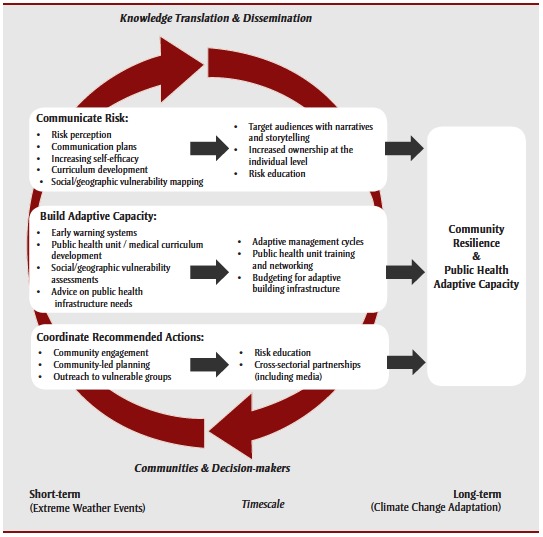
The conceptual framework includes a knowledge translation and dissemination feedback cycle which involves communities and public health policy decision-makers. The feedback cycle intersects with horizontal local and institutional efforts to communicate EWCC risk, build adaptive capacity and coordinate recommended actions across short- and long-term timescales. In the conceptual framework, communities receive risk messages and share feedback in the form of content and lived experience with the public health practitioners and decision-makers who then intelligently adapt EWCC materials in response to grassroots feedback as part of an ongoing process. By applying several of the methods highlighted in the scoping review (e.g., community engagement, targeting audiences, creating adaptive management systems), this model visually represents how public health policy makers, decision makers and educators could become integral to a risk communication framework whose goal is to continually enhance adaptive capacity to climate change and build community resilience.
Some articles addressed more than one type of EWCC risk communication.
Discussion
Results from the scoping review and information- gathering and validation workshop highlight important features regarding EWCC risk communication strategies and related practices. The scoping literature review covered diverse issues, jurisdictions and decision-making bodies. It identified methodological approaches and gaps that can affect research outcomes. Public media, community workshops and expert presentations were the most common practices cited for communicating extreme weather risk. Eighteen articles covered how inclusive community-based approaches, such as hazard mapping and scenario planning, allow decision-makers, such as government, to work alongside the general public in a way that encourages mutual respect and increases individual action. This type of communication practice could present a unique opportunity for public health practitioners, who often rely on promotional messaging such as temperature alerts, as EWCC risk communication tools.2
Grey literature identified that humanitarian organizations such as the Red Cross are taking the lead in social media, disaster preparedness, health adaptation and community engagement.41 These include preparedness iPhone apps and combining local radio, SMS and crisis mapping into community-sourced-communication tools for extreme weather events and citizen preparedness. 54 Public participation measures with diverse community stakeholders appear to be the most effective means to raise awareness of disaster preparedness, promote effective individual responses — and increase community trust and cooperation in planning and messaging.
A common theme among communication articles was addressing risk perception. Many variables affect how EWCC events are perceived and addressed by individuals and communities. Factors such as selfefficacy, personal experience with hazards, and how long individuals have lived in a potentially affected location all contributed to the perception of the level of threat of an extreme weather event. The state of individual and community risk perception is important to consider in any EWCC risk communication strategy. None of the eighteen articles that addressed risk perception evaluated risk communication strategies, yet it appears some of these factors influence risk perception (e.g., self-efficacy, duration of residence) while others can predict whether individuals will act (e.g., response efficacy).
Despite many authors highlighting that risk communications should be understood as a “two-way exchange between parties,” the current literature suggests that most communication is a uni-directional warning from decision-makers to an uninvolved public, rather than a dialogue. 50 Thus, EWCC is largely being discussed at a high level through official media or advocacy campaigns and less so at the household or community level, and is not well integrated across platforms. Tailored, people-centered risk communication practices have been shown to be more effective than top-down approaches.55
Research gaps surrounding EWCC risk communications included a shortage of empirical studies and a limited amount of applied theory in study design and execution. Because extreme weather events sometimes occur with little warning, measuring pre-event preparedness and behaviour change is difficult. Even so, the reviewed literature is context specific and difficult to use to generate programs and frameworks because the approaches to measuring variables such as risk perception and a willingness to act are not cohesive or consistent. Another gap in the research was a lack of evaluation of current risk communications strategies. Several authors highlighted poor integration of community-led initiatives in future planning, often because such initiatives were not properly evaluated. The final major gap in the research base relates to a focus on individuals, at the expense of the household and extended family networks. In relation to vulnerable communities (and wider society), authors argued that research should address how decisionmaking within families affects risk perception and responses during extreme weather events. Future research might therefore include families and various intimate social groupings as a starting point in theoretical frameworks and allow analysis of household dynamics as they pertain to preparedness activity for EWCC risks. Due to the English language restriction used to search published and grey literature, it is possible that relevant research and risk communication efforts were not captured in our scoping review.
The literature shows that a promising risk communications strategy for decision makers and scientists is to acknowledge uncertainty to counter scepticism, improve communication transparency, and enhance trust and credibility.18,42 Improved communications about uncertain aspects of climate change require collaboration25 and carefully targeting messages to each unique audience.42 Bridging the knowledge divide between experts and the public to improve risk communication is necessary and could include developing risk communications standards and improving knowledge exchange among complementary domains of learning and practice.25
While the relationship between extreme weather and climate change is increasingly clear, the reviewed literature suggests that researchers have not been able to identify risk communication strategies that span the short- and long-term responses recommended for key audiences. Some studies referred generally to “climate change” but did not provide specific examples of potential threats or climate impacts, making it difficult to identify key approaches that would be effective in communicating a wide variety of risks to a disparate set of audiences. The conceptual framework presented here is intended not only to support EWCC risk communication, but also to build adaptive capacity and coordinate recommended actions across short- and long-term timescales.
Conclusion
To meet the OPHS 2018 requirements, public health unit staff need to engage in effective risk communication that motivate local actions to mitigate the effects of extreme weather and climate change. The issue for public health professionals is that there is little evidence on which to base risk communication strategies,56 particularly for the long-term impacts of climate change. Best practices include community engagement, initiatives to enhance self-efficacy of individuals and communities, targeting unique audiences and bi-directional communications among leaders and stakeholders. Promising practices such as stakeholder coordination, participatory workshops and addressing vulnerable populations are similar to emerging best practice.
Public health practitioners and decision makers are important intermediaries in EWCC risk communications and provide necessary knowledge to motivate a healthy response to evidence of accumulating EWCC risks.57 Extreme weather related to climate change is a growing threat to Canadians. Preparedness for and actions taken at individual, family, community, organizational and system levels can mitigate risks associated with these threats. Based on the evidence review, risk communication efforts during short-term extreme weather events appear to be more effective than efforts to communicate risk around climate change. This distinction could highlight a unique opportunity for public health to adapt strategies commonly used for extreme weather to climate change.
Acknowledgements
This project was funded by Public Health Ontario. We thank the library services team at Public Health Ontario for developing and running the search strategies for the scoping review, in particular Allison McArthur, Susan Massarella, Lindsay Harker and Sarah Morgan. We also thank Cathy Mallove for sharing her communications expertise throughout the project.
Conflicts of interest
The authors declare no conflicts of interest.
Authors’ contributions and statement
EM drafted and revised the manuscript. SK designed the project, screened articles, developed the conceptual framework and reviewed the manuscript. AD reviewed and screened articles for relevance, drafted the workshop report and reviewed the manuscript. RC supervised the project and reviewed the manuscript. BS supervised Health Promotion and Chronic Disease Prevention in Canada 154 Research, Policy and Practice Vol 39, No 4, April 2019 the project, developed the conceptual framework and reviewed the manuscript.
The content and views expressed in this article are those of the authors and do not necessarily reflect those of the Government of Canada.
References
- Trenberth K, et al. Framing the way to relate climate extremes to climate change. Climatic Change. 2012:283–90. [Google Scholar]
- Paterson JA, Ford JD, Ford LB, et al, et al. Adaptation to climate change in the Ontario public health sector. BMC Public Health. 2012:452–90. doi: 10.1186/1471-2458-12-452. [DOI] [PMC free article] [PubMed] [Google Scholar]
- Ebi KL, Berry P, Hayes K, et al, et al. Stress testing the capacity of health systems to manage climate change-related shocks and stresses. Int J Environ Res Public Health. 2018;15((11)):2370–90. doi: 10.3390/ijerph15112370. [DOI] [PMC free article] [PubMed] [Google Scholar]
- Levison MM, Butler AJ, Rebellato S, Armstrong B, Whelan M, Gardner C, et al. Development of a climate change vulnerability assessment using a public health lens to determine local health vulnerabilities: an Ontario Health Unit experience. Int J Environ Res Public Health. 2018;15((10)):2626–90. doi: 10.3390/ijerph15102237. [DOI] [PMC free article] [PubMed] [Google Scholar]
- Buse CG, et al. Why should public health agencies across Canada conduct climate change and health vulnerability assessments. Can J Public Health. 2018;109((5-6)):782–5. doi: 10.17269/s41997-018-0118-6. [DOI] [PMC free article] [PubMed] [Google Scholar]
- Salman AM, Li Y, et al. Flood risk assessment, future trend modeling, and risk communication: a review of ongoing research. Nat Hazards Rev. 2018 [Google Scholar]
- Brecher RW, Copes R, et al. Queen’s Printer for Ontario. Toronto(ON): 2016. EOH fundamentals: risk communication. [Google Scholar]
- McMartin DW, Sammel AJ, Arbuthnott K, et al. Community response and engagement during extreme water events in Saskatchewan, Canada and Queensland, Australia. Environ Manage. 2018;61((1)):34–45. doi: 10.1007/s00267-017-0944-y. [DOI] [PMC free article] [PubMed] [Google Scholar]
- Dodd W, Scott P, Howard C, et al. Lived experience of a record wildfire season in the Northwest Territories, Canada. Can J Public Health. 2018;109((3)):327–37. doi: 10.17269/s41997-018-0070-5. [DOI] [PMC free article] [PubMed] [Google Scholar]
- Pilla F, Gharbia SS, Lyons R, et al. How do households perceive flood-risk. Sci Total Environ. 2019;650((Pt 1)):144–54. doi: 10.1016/j.scitotenv.2018.08.439. [DOI] [PubMed] [Google Scholar]
- Blashki G, Armstrong G, Berry HL, et al, et al. Preparing health services for climate change in Australia. Preparing health services for climate change in Australia. Asia-Pacific Journal of Public Health. 2011;23((2 suppl)) doi: 10.1177/1010539510395121. [DOI] [PubMed] [Google Scholar]
- Malley L, et al. Scoping studies: towards a methodological framework. Int J Soc Res Methodol. 2005;8((1)):19–32. [Google Scholar]
- Akompab DA, Bi P, Williams S, et al, et al. Heat waves and climate change: applying the health belief model to identify predictors of risk perception and adaptive behaviours in Adelaide, Australia. Int J Environ Res Public Health. 2013;10((6)):2164–84. doi: 10.3390/ijerph10062164. [DOI] [PMC free article] [PubMed] [Google Scholar]
- Bajayo R, et al. Building community resilience to climate change through public health planning. Bajayo R. 2012;23((1)):30–6. doi: 10.1071/he12030. [DOI] [PubMed] [Google Scholar]
- Bubeck P, Botzen WJ, Aerts JC, et al. A review of risk perceptions and other factors that influence flood mitigation behavior. Risk Analysis. 2012;32((9)):1481–95. doi: 10.1111/j.1539-6924.2011.01783.x. [DOI] [PubMed] [Google Scholar]
- Buchecker M, Menzel S, Home R, et al. How much does participatory flood management contribute to stakeholders' social capacity building. Natural Hazards and Earth System Science. 2013;13((6)):1427–44. [Google Scholar]
- Burningham K, Fielding J, Thrush D, et al. 'It'll never happen to me': understanding public awareness of local flood risk. Disasters. 2008;32((2)):216–38. doi: 10.1111/j.1467-7717.2007.01036.x. [DOI] [PubMed] [Google Scholar]
- Buys L, Aird R, Megen K, et al, et al. Perceptions of climate change and trust in information providers in rural Australia. Public Understanding of Science. 2014;23((2)):170–88. doi: 10.1177/0963662512449948. [DOI] [PubMed] [Google Scholar]
- Gaillard JC, et al. Integrating knowledge and actions in disaster risk reduction: the contribution of participatory mapping. Area. 2012;44((1)):100–9. [Google Scholar]
- Cairns G, Ahmed I, Mullett J, et al, et al. Scenario method and stakeholder engagement: critical reflections on a climate change scenarios case study. Technological Forecasting and Social Change. 2013;80((1)):1–10. [Google Scholar]
- Chen V, Banerjee D, Liu L, et al. Do people become better prepared in the aftermath of a natural disaster. Do people become better prepared in the aftermath of a natural disaster? The hurricane Ike experience in Houston, Texas. Journal of Public Health Management & Practice. 2012;18((3)):241–9. doi: 10.1097/PHH.0b013e31822d4beb. [DOI] [PubMed] [Google Scholar]
- Coulston JE, Deeny P, et al. Prior exposure to major flooding increases individual preparedness in high-risk populations. Prior exposure to major flooding increases individual preparedness in high-risk populations. Prehospital & Disaster Medicine. 2010;25((4)):289–95. doi: 10.1017/s1049023x00008219. [DOI] [PubMed] [Google Scholar]
- Driscoll DL, Sunbury T, Johnston J, et al, et al. Initial findings from the implementation of a community-based sentinel surveillance system to assess the health effects of climate change in Alaska. Int J Circumpolar Health. 2013 doi: 10.3402/ijch.v72i0.21405. [DOI] [PMC free article] [PubMed] [Google Scholar]
- Eisenman DP, Cordasco KM, Asch S, et al, et al. Disaster planning and risk communication with vulnerable communities: lessons from Hurricane Katrina. Am J Public Health. 2007;97((Suppl 1)):S109–15. doi: 10.2105/AJPH.2005.084335. [DOI] [PMC free article] [PubMed] [Google Scholar]
- Faulkner H, Parker D, Green C, et al, et al. Developing a translational discourse to communicate uncertainty in flood risk between science and the practitioner. Ambio. 2007;36((8)):692–703. doi: 10.1579/0044-7447(2007)36[692:datdtc]2.0.co;2. [DOI] [PubMed] [Google Scholar]
- Fitzpatrick-Lewis D, Yost J, Ciliska D, et al, et al. Communication about environmental health risks: a systematic review. Communication about environmental health risks: a systematic review. Environmental Health: A Global Access Science Source. 2010 doi: 10.1186/1476-069X-9-67. [DOI] [PMC free article] [PubMed] [Google Scholar]
- Heilbrun K, Wolbransky M, Shah S, et al, et al. Risk communication of terrorist acts, natural disasters, and criminal violence: comparing the processes of understanding and responding. Behav Sci Law. 2010;28((6)):717–29. doi: 10.1002/bsl.940. [DOI] [PubMed] [Google Scholar]
- Hess JJ, McDowell JZ, Luber G, et al. Integrating climate change adaptation into public health practice: using adaptive management to increase adaptive capacity and build resilience. Environ Health Perspect. 2012;120((2)):171–9. doi: 10.1289/ehp.1103515. [DOI] [PMC free article] [PubMed] [Google Scholar]
- Messias DK, Barrington C, Lacy E, et al. Latino social network dynamics and the Hurricane Katrina disaster. Disasters. 2012;36((1)) doi: 10.1111/j.1467-7717.2011.01243.x. [DOI] [PubMed] [Google Scholar]
- Horney JA, Nguyen M, Cooper J, et al, et al. Accounting for vulnerable populations in rural hazard mitigation plans: results of a survey of emergency managers. Journal of Emergency Management. 2013;11((3)):201–11. doi: 10.5055/jem.2013.0138. [DOI] [PubMed] [Google Scholar]
- Ireland P, Thomalla F, et al. The role of collective action in enhancing communities' adaptive capacity to environmental risk: an exploration of two case studies from Asia. PLoS Currents. :1–16. doi: 10.1371/currents.RRN1279. [DOI] [PMC free article] [PubMed] [Google Scholar]
- Kellens W, Zaalberg R, Maeyer P, et al. The informed society: an analysis of the public's information-seeking behavior regarding coastal flood risks. Risk Analysis. 2012;32((8)):1369–81. doi: 10.1111/j.1539-6924.2011.01743.x. [DOI] [PubMed] [Google Scholar]
- Kellens W, Terpstra T, Maeyer P, et al. Perception and communication of flood risks: a systematic review of empirical research. Risk Analysis. 2013;33((1)):24–49. doi: 10.1111/j.1539-6924.2012.01844.x. [DOI] [PubMed] [Google Scholar]
- Kim YC, Kang J, et al. Communication, neighbourhood belonging and household hurricane preparedness. Disasters. 2010;34((2)):470–88. doi: 10.1111/j.1467-7717.2009.01138.x. [DOI] [PubMed] [Google Scholar]
- Kuhlicke C, Steinfuhrer C, et al. Social capacity building for natural hazards: a conceptual frame. Kuhlicke C, Steinfuhrer C. 2010 [Google Scholar]
- Maibach EW, Roser-Renouf C, Leiserowitz A, et al. Communication and marketing as climate change-intervention assets a public health perspective. Am J Prev Med. 2008;35((5)):488–500. doi: 10.1016/j.amepre.2008.08.016. [DOI] [PubMed] [Google Scholar]
- Martin WE, Martin IM, Kent B, et al. The role of risk perceptions in the risk mitigation process: the case of wildfire in high-risk communities. J Environ Manage. 2009;91((2)):489–98. doi: 10.1016/j.jenvman.2009.09.007. [DOI] [PubMed] [Google Scholar]
- Mullins A, Soetanto R, et al. Ethnic differences in perceptions of social responsibility: informing risk communication strategies for enhancing community resilience to flooding. Disaster Prev Manage. 2013;22((2)):119–31. [Google Scholar]
- O’Sullivan T, Kuziemsky CE, Toal-Sullivan D, et al, et al. Unravelling the complexities of disaster management: a framework for critical social infrastructure to promote population health and resilience. Soc Sci Med. 2013:238–46. doi: 10.1016/j.socscimed.2012.07.040. [DOI] [PMC free article] [PubMed] [Google Scholar]
- Pidgeon N, Fischhoff B, et al. The role of social and decision sciences in communicating uncertain climate risks. Nature Climate Change. 2011 [Google Scholar]
- Poutiainen C, Berrang-Ford L, Ford J, et al, et al. Civil society organizations and adaptation to the health effects of climate change in Canada. Public Health. 2013;127((5)):403–9. doi: 10.1016/j.puhe.2013.02.004. [DOI] [PubMed] [Google Scholar]
- Rabinovich A, Morton TA, et al. Unquestioned answers or unanswered questions: beliefs about science guide responses to uncertainty in climate change risk communication. Risk Analysis. 2012;32((6)):992–1002. doi: 10.1111/j.1539-6924.2012.01771.x. [DOI] [PubMed] [Google Scholar]
- Reynolds B, et al. When the facts are just not enough: credibly communicating about risk is riskier when emotions run high and time is short. Toxicol Appl Pharmacol. 2011:206–214. doi: 10.1016/j.taap.2010.10.023. [DOI] [PubMed] [Google Scholar]
- Roeser S, et al. Risk communication, public engagement, and climate change: a role for emotions. Risk Analysis. 2012;32((6)):1033–40. doi: 10.1111/j.1539-6924.2012.01812.x. [DOI] [PubMed] [Google Scholar]
- Severtson DJ, et al. The influence of environmental hazard maps on risk beliefs, emotion, and health-related behavioral intentions. Res Nurs Health. 2013;36((4)):330–48. doi: 10.1002/nur.21544. [DOI] [PMC free article] [PubMed] [Google Scholar]
- Shaw A, Flanders D, et al, et al. Future visioning of local climate change: a framework for community engagement and planning with scenarios and visualisation. Futures. 2011;43((4)):400–12. [Google Scholar]
- Spence A, Poortinga W, Pidgeon N, et al. The psychological distance of climate change. Risk Analysis. 2012;32((6)):957–72. doi: 10.1111/j.1539-6924.2011.01695.x. [DOI] [PubMed] [Google Scholar]
- Stewart RM, Rashid H, et al. Community strategies to improve flood risk communication in the Red River Basin, Manitoba, Canada. Disasters. 2011;35((3)):554–76. doi: 10.1111/j.1467-7717.2010.01222.x. [DOI] [PubMed] [Google Scholar]
- Taylor-Clark K, Koh H, Viswanath K, et al. Perceptions of environmental health risks and communication barriers among low-SEP and racial/ethnic minority communities. J Health Care Poor Underserved. 2007;18((4 Suppl)) doi: 10.1353/hpu.2007.0113. [DOI] [PubMed] [Google Scholar]
- Tinker TL, et al. Communicating and managing change during extreme weather events: promising practices for responding to urgent and emergent climate threats. J Bus Contin Emer Plan. 2013;6((4)):304–13. [PubMed] [Google Scholar]
- Wachinger G, Renn O, Begg C, et al, et al. The risk perception paradox–implications for governance and communication of natural hazards. Risk Analysis. 2013;33((6)):1049–65. doi: 10.1111/j.1539-6924.2012.01942.x. [DOI] [PubMed] [Google Scholar]
- Yamada F, Kakimoto R, Yamamoto M, et al, et al. Implementation of community flood risk communication in Kumamoto, Japan. J Adv Transport. 2011;45((2)) [Google Scholar]
- -28. [Google Scholar]
- Zia A, Todd AM, et al. Evaluating the effects of ideology on public understanding of climate change science: how to improve communication across ideological divides. Zia A, Todd AM. 2010;19((6)):743–61. doi: 10.1177/0963662509357871. [DOI] [PubMed] [Google Scholar]
- World disasters report: Focus on technology and the future of humanitarian action (Internet) International Federation of Red Cross and Red Crescent Societies. 2013 Available from: http://www.ifrc.org/PageFiles/134658/WDR%202013%20complete.pdf. [Google Scholar]
- Haer T, et al. The effectiveness of flood risk communication strategies and the influence of social networks–Insights from an agent-based model. Environmental Science and Policy. 2016:44–52. [Google Scholar]
- Capstick S, Whitmarsh L, Poortinga W, et al, et al. International trends in public perceptions of climate change over the past quarter century. WIREs Clim Change. 2015 [Google Scholar]
- Chadwick AE, et al. Climate change, health, and communication: a primer. Health Commun. 2016;31((6)):782–5. doi: 10.1080/10410236.2014.1002030. [DOI] [PubMed] [Google Scholar]


